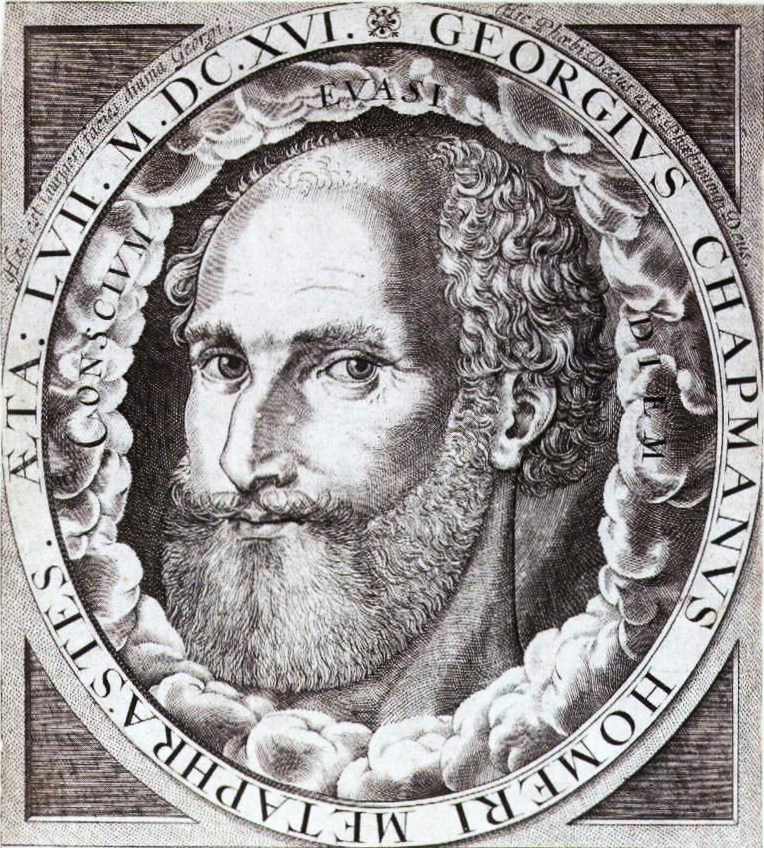George Chapman (George Chapman)

Poet, Playwright, Translator. He was the first to translate the works of Homer into English, beginning with his “Seven Books of the Iliad” in 1598. This was followed by the complete “Iliad” in 1611, the “Odyssey” in 1615, and “The Whole Works of Homer” in 1616. Chapman took liberties with the material that reflected his own creative concerns but the translations are still a significant literary achievement on their own. In his original writings he addressed moral and philosophical issues. The historical tragedy “Bussy D’Ambois” (1607) is the greatest of his plays. He also completed Christopher Marlowe’s unfinished long poem “Hero and Leander” (published 1598). Chapman was born at Hitchin in Hertfordshire, England. Little is known of his early life though his erudition suggests he had a university education, possibly at Oxford. In the early 1590s he saw military action in the Low Countries. His first published work was the poem “The Shadow of Night” (1594) and by the end of the decade he was established as a playwright for Philip Henslowe’s theatre companies in London. His were plays of ideas rather than of action or character, but several found favor with contemporary audiences. Chapman’s “An Humourous Day’s Mirth” (1597) started a vogue for “humours comedies”, in which each character is driven by a single “humour”, or personality trait, such as jealousy. It had a decisive influence on Ben Jonson. More engaging are the farces “All Fools” (c. 1604) and “May Day” (c. 1610). In 1605 he co-wrote a satirical play with Jonson and John Marston, “Eastward Ho”, with political humor and anti-Scottish sentiments that offended King James I; the authors were briefly imprisoned and threatened with having their ears and noses cut off. His most successful tragedies, “Bussy D’Ambois”, the two-part “The Conspiracy and Tragedy of Charles, Duke of Byron (1608), “The Revenge of Bussy D’Ambois” (1613), and “The Tragedy of Chabot, Admiral of France” (c. 1620) were all based on recent French history and center on the corruption of a great man’s ideals. Jonson considered Chapman second only to himself as a creator of masques (entertainments for the royal court) but only one survives, “The Memorable Masque of the Middle Temple and Lincoln’s Inn” (1613). Chapman was hounded by debt throughout his life. He was singularly unlucky in his choice of patrons, including the Earl of Essex (executed for treason in 1601) and the Earl of Somerset (convicted of conspiracy in the murder of Sir Thomas Overbury in 1615). Henry the Prince of Wales urged him to complete his Homer translations with assurances of a generous gift and pension, but the Prince died in 1612 and Chapman was never able to collect what was promised him. He died in poverty in London. His unusual Romanesque tombstone was designed and paid for by his friend Inigo Jones. Chapman’s renderings of the “Iliad” and “Odyssey” introduced the English-speaking world to the glories of the man he called “The Prince of Poets”, and were preferred by some literati even after the more polished translations of Dryden and Pope. The finest tribute was paid by John Keats in his sonnet “On First Looking into Chapman’s Homer” (1816), with its famous opening line, “Much have I travell’d in the realms of gold”. (bio by: Bobb Edwards)
Born
- January, 01, 1970
- England
Died
- May, 05, 1634
- England
Cemetery
- St Giles in the Fields Churchyard
- England

